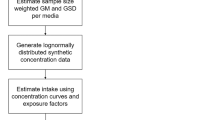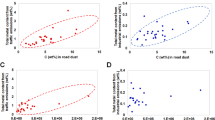Abstract
Chemical exposure via dust ingestion is of great interest to researchers and regulators because children are exposed to dust through their daily activities, and as a result, to the many chemicals contained within dust. Our goal was to develop a workflow to identify and rank organic chemicals that could be used as tracers to calculate children’s dust ingestion rates. We proposed a set of criteria for a chemical to be considered a promising tracer. The best tracers must be (1) ubiquitous in dust, (2) unique to dust, (3) detectable as biomarkers in accessible biological samples, and (4) have available or obtainable ADME information for biomarker-based exposure reconstruction. To identify compounds meeting these four criteria, we developed a workflow that encompasses non-targeted analysis approaches, literature and database searching, and multimedia modeling. We then implemented an ad hoc grading system and ranked candidate chemicals based on fulfillment of our criteria (using one small, publicly available dataset to show proof of concept). Initially, five chemicals (1,3-diphenylguanidine, leucine, piperine, 6:2/8:2 fluorotelomer phosphate diester, 6:2 fluorotelomer phosphate diester) appeared to satisfy many of our criteria. However, a rigorous manual investigation raised many questions about the applicability of these chemicals as tracers. Based on the results of this initial pilot study, no individual compounds can be unequivocally considered suitable tracers for calculating dust ingestion rates. Future work must therefore consider larger datasets, generated from broader measurement studies and literature searches, as well as refinements to selection criteria, to identify robust and defensible tracer compounds.
This is a preview of subscription content, access via your institution
Access options
Subscribe to this journal
Receive 6 print issues and online access
$259.00 per year
only $43.17 per issue
Buy this article
- Purchase on Springer Link
- Instant access to full article PDF
Prices may be subject to local taxes which are calculated during checkout



Similar content being viewed by others
References
Moya J, Phillips L. A review of soil and dust ingestion studies for children. J Expo Sci Env Epid. 2014;24:545–54.
Mercier F, Glorennec P, Thomas O, Le Bot B. Organic contamination of settled house dust, a review for exposure assessment purposes. Environ Sci Technol. 2011;45:6716–27.
U.S. EPA. Soil and dust ingestion. exposure factors handbook. Washington, DC: National Center for Environmental Assessment, Office of Research and Development, U.S. Environmental Protection Agency; 2017.
Tulve NS, Suggs JC, McCurdy T, Hubal EAC, Moya J. Frequency of mouthing behavior in young children. J Expo Anal Env Epidemiol. 2002;12:259–64.
Bjorklund JA, Thuresson K, De Wit CA. Perfluoroalkyl compounds (PFCs) in indoor dust: concentrations, human exposure estimates, and sources. Environ Sci Technol. 2009;43:2276–81.
Bennett DH, Moran RE, Wu XM, Tulve NS, Clifton MS, Colon M, et al. Polybrominated diphenyl ether (PBDE) concentrations and resulting exposure in homes in California: relationships among passive air, surface wipe and dust concentrations, and temporal variability. Indoor Air. 2015;25:220–9.
von Lindern I, Spalinger S, Petroysan V, von Braun M. Assessing remedial effectiveness through the blood lead: soil/dust lead relationship at the Bunker Hill Superfund Site in the Silver Valley of Idaho. Sci Total Environ. 2003;303:139–70.
U.S. EPA. Guidance manual for the integrated exposure uptake biokinetic model for lead in children. Washington, DC: Office of Emergency and Remedial Response; 1994. EPA/540/R-93/081.
U.S. EPA. Technical support document: parameters and equation used in the integrated exposure uptake biokinetic (IEUBK) model for lead in children (v0.99d). Washington, DC: Office of Emergency and Remedial Response; 1994. EPA/540/R-94/040.
U.S. EPA. OSWER directive #9355.4-12 revised interim soil lead guidance for CERCLA sites and RCRA corrective action facilities. Washigton, DC: EPA; 1994. EPA/540/F-94/043.
Calabrese E, Stanek E. Distinguishing outdoor soil ingestion from indoor dust ingestion in a soil pica child. Regul Toxicol Pharm. 1992;15:83–5.
Ozkaynak H, Xue JP, Zartarian VG, Glen G, Smith L. Modeled estimates of soil and dust ingestion rates for children. Risk Anal. 2011;31:592–608.
Trunnelle KJ, Bennett DH, Tulve NS, Clifton MS, Davis MD, Calafat AM, et al. Urinary pyrethroid and chlorpyrifos metabolite concentrations in Northern California families and their relationship to indoor residential insecticide levels, part of the Study of Use of Products and Exposure Related Behavior (SUPERB). Environ Sci Technol. 2014;48:1931–9.
Geens T, Roosens L, Neels H, Covaci A. Assessment of human exposure to bisphenol-A, triclosan and tetrabromobisphenol-A through indoor dust intake in Belgium. Chemosphere. 2009;76:755–60.
Lu XW, Zhang XL, Li LY, Chen H. Assessment of metals pollution and health risk in dust from nursery schools in Xi'an, China. Environ Res. 2014;128:27–34.
Moschet C, Anumol T, Lew BM, Bennett DH, Young TM. Household dust as a repository of chemical accumulation: new insights from a comprehensive high-resolution mass spectrometric study. Environ Sci Technol. 2018;52:2878–87.
Rager JE, Strynar MJ, Liang S, McMahen RL, Richard AM, Grulke CM, et al. Linking high resolution mass spectrometry data with exposure and toxicity forecasts to advance high-throughput environmental monitoring. Environ Int. 2016;88:269–80.
NIST. NIST Standard Reference Database 14 [updated December 12, 2018]. Available from: https://www.nist.gov/srd/nist-standard-reference-database-1a-v17.
MetFrag. MetFrag 2010 [December 19, 2018]. Available from: http://c-ruttkies.github.io/MetFrag/.
Schymanski EL, Jeon J, Gulde R, Fenner K, Ruff M, Singer HP, et al. Identifying small molecules via high resolution mass spectrometry: communicating confidence. Environ Sci Technol. 2014;48:2097–8.
Webster EM, Oian H, Mackay D, Christensen RD, Tietjen B, Zaleski R. Modeling human exposure to indoor contaminants: external source to body tissues. Environ Sci Technol. 2016;50:8697–704.
Mackay D. Multimedia environmental models: the fugacity approach. 2nd ed. CRC Press; 2001.
Bennett DH, Furtaw EJ. Fugacity-based indoor residential pesticide fate model. Environ Sci Technol. 2004;38:2142–52.
Liagkouridis I, Cequier E, Lazarov B, Cousins AP, Thomsen C, Stranger M, et al. Relationships between estimated flame retardant emissions and levels in indoor air and house dust. Indoor Air. 2017;27:650–7.
Rudel RA, Camann DE, Spengler JD, Korn LR, Brody JG. Phthalates, alkylphenols, pesticides, polybrominated diphenyl ethers, and other endocrine-disrupting compounds in indoor air and dust. Environ Sci Technol. 2003;37:4543–53.
Newton S, Sellstrom U, de Wit CA. Emerging flame retardants, PBDEs, and HBCDDs in indoor and outdoor media in Stockholm, Sweden. Environ Sci Technol. 2015;49:2912–20.
U.S. EPA. CompTox Dashboard 2018 [November 2, 2018]. Available from: https://comptox.epa.gov/dashboard.
U.S. EPA. EPI Suite—Estimation Program Interface 2000 [November 2, 2018]. Available from: https://www.epa.gov/tsca-screening-tools/epi-suitetm-estimation-program-interface.
NIEHS. NTP Technical report on toxicity studies of 1,3-diphenylguanidine. 1995 42.
Aizawa A, Ito A, Masui Y, Sasaki K, Ishimura Y, Numata M, et al. A case of allergic contact dermatitis caused by goalkeeper gloves. Contact Dermat. 2018;79:113–5.
Dejonckheere G, Herman A, Baeck M. Allergic contact dermatitis caused by synthetic rubber gloves in healthcare workers: sensitization to 1,3-diphenylguanidine is common. Contact Dermat. 2019;81:167–73.
Hamnerius N, Ponten A, Bjork J, Persson C, Bergendorff O. Skin exposure to the rubber accelerator diphenylguanidine in medical gloves - an experimental study. Contact Dermat. 2019;81:9–16.
Tang J, Tang L, Zhang C, Zeng G, Deng Y, Dong H. et al. Differ senescent HDPE pipe-risk: brief field Investig source water tap water China (Changsha City). Environ Sci Pollut R. 2015;22:16210–4.
Wishart DS, Tzur D, Knox C, Eisner R, Guo AC, Young N, et al. HMDB: The Human Metabolome Database. Nucleic Acids Res. 2007;35(Database):D521–6.
Wishart DS, Knox C, Guo AC, Eisner R, Young N, Gautam B, et al. HMDB: a knowledgebase for the human metabolome. Nucleic Acids Res. 2009;37(Database):D603–10.
Wishart DS, Jewison T, Guo AC, Wilson M, Knox C, Liu Y, et al. HMDB 3.0-The Human Metabolome Database in 2013. Nucleic Acids Res. 2013;41(Database):D801–7.
Wishart DS, Feunang YD, Marcu A, Guo AC, Liang K, Vazquez-Fresno R, et al. HMDB 4.0: The Human Metabolome Database for 2018. Nucleic Acids Res. 2018;46(D1):D608–d17.
Liu HL, Luo R, Chen XQ, Ba YY, Zheng L, Guo WW, et al. Identification and simultaneous quantification of five alkaloids in Piper longum L. by HPLC-ESI-MSn and UFLC-ESI-MS/MS and their application to Piper nigrum L. Food Chem. 2015;177:191–6.
U.S. EPA. Piperine (043501) Fact sheet 2004 [March 12, 2019]. Available from: https://www3.epa.gov/pesticides/chem_search/reg_actions/registration/fs_PC-043501_01-Oct-04.pdf.
Ren TJ, Hu MY, Cheng Y, Shek TL, Xiao M, Ho NJ, et al. Piperine-loaded nanoparticles with enhanced dissolution and oral bioavailability for epilepsy control. Eur J Pharm Sci. 2019;137:104988.
Hussaarts K, Hurkmans DP, Oomen-de Hoop E, van Harten LJ, Berghuis S, van Alphen RJ, et al. Impact of curcumin (with or without piperine) on the pharmacokinetics of tamoxifen. Cancers (Basel). 2019;11:403.
D'Eon JC, Crozier PW, Furdui VI, Reiner EJ, Libelo EL, Mabury SA. Observation of a commercial fluorinated material, the polyfluoroalkyl phosphoric acid diesters, in human sera, wastewater treatment plant sludge, and paper fibers. Environ Sci Technol. 2009;43:4589–94.
Gebbink WA, Ullah S, Sandblom O, Berger U. Polyfluoroalkyl phosphate esters and perfluoroalkyl carboxylic acids in target food samples and packaging-method development and screening. Environ Sci Pollut R. 2013;20:7949–58.
De Silva AO, Allard CN, Spencer C, Webster GM, Shoeib M. Phosphorus-containing fluorinated organics: polyfluoroalkyl phosphoric acid diesters (diPAPs), perfluorophosphonates (PFPAs), and perfluorophosphinates (PFPIAs) in residential indoor dust. Environ Sci Technol. 2012;46:12575–82.
Yeung LW, Robinson SJ, Koschorreck J, Mabury SA. Part I. A temporal study of PFCAs and their precursors in human plasma from two German cities 1982–2009. Environ Sci Technol. 2013;47:3865–74.
Jin HB, Zhang YF, Zhu LY, Martin JW. Isomer profiles of perfluoroalkyl substances in water and soil surrounding a Chinese fluorochemical manufacturing park. Environ Sci Technol. 2015;49:4946–54.
Acknowledgements
The authors thank Kathie Dionisio and Kent Thomas (U.S. EPA) for their insightful reviews of the manuscript. This project was supported by an appointment to the Internship/Research Participation Program at the U.S. Environmental Protection Agency, Office of Research and Development, National Exposure Research Laboratory, Systems Exposure Division, administered by the Oak Ridge Institute for Science and Education (ORISE) through an interagency agreement between the U.S. Department of Energy and EPA. The views expressed in this manuscript are those of the author(s) and do not necessarily represent the views or policies of the EPA. It has been subjected to Agency administrative review and approved for publication. Mention of trade names or commercial products does not constitute endorsement or recommendation for use.
Author information
Authors and Affiliations
Corresponding author
Ethics declarations
Conflict of interest
The authors declare that they have no conflict of interest.
Additional information
Publisher’s note Springer Nature remains neutral with regard to jurisdictional claims in published maps and institutional affiliations.
Supplementary information
Rights and permissions
About this article
Cite this article
Panagopoulos Abrahamsson, D., Sobus, J.R., Ulrich, E.M. et al. A quest to identify suitable organic tracers for estimating children’s dust ingestion rates. J Expo Sci Environ Epidemiol 31, 70–81 (2021). https://doi.org/10.1038/s41370-020-0244-0
Received:
Revised:
Accepted:
Published:
Issue Date:
DOI: https://doi.org/10.1038/s41370-020-0244-0
Keywords
This article is cited by
-
Optimization of a method for collecting infant and toddler urine for non-target analysis using cotton pads and commercially available disposable diapers
Journal of Exposure Science & Environmental Epidemiology (2023)
-
Model based prediction of age-specific soil and dust ingestion rates for children
Journal of Exposure Science & Environmental Epidemiology (2022)



